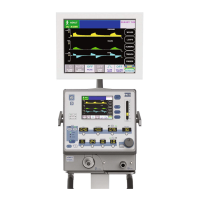OPR360US H0711
5-1
Alarms
5
Introduction
The e360 Ventilator is equipped with an audible and visual alarm
system to help ensure patient safety. This section describes the
procedure for setting alarm limits, lists all alarms and includes a
Violation and Remedy Guide in Table 5-1. Alarm specifications are
located in Section 8 of this manual.
Visual and audible alarms warn about:
• Patient breathing problems such as apnea or high and low airway
pressure.
• Power problems such as a loss of AC power.
• Problems with gases such as low supply pressure of oxygen.
• Hardware problems such as overheating or memory failure.
NOTE: The e360 Ventilator powers up using the most recently
selected alarm limits. The MVE and Disconnect Threshold alarms may
be set to OFF in NIV. Those settings are not retained. See Section 7,
Non Invasive Ventilation for details.
WARNING: Failure to identify and correct alarm conditions can result
in patient injury. To ensure continued operation of the ventilator when
a Low Battery Alarm occurs, substitute an alternate power source
immediately. AC Power is always the preferred power source.
WARNING: Always ensure that the caregiver can hear the audible
alert when the alarm sounds. Do not use the ventilator in an
environment where audible alarms cannot be heard by the caregivers.
Visual Alarm Displays
The e360 displays the following visual information when an alarm is
violated:
The 360˚ Alarm Lamp
Refer to Foldout F-4, item 4.
Located at the top center of the e360 front panel, the 360˚ Alarm
Lamp flashes yellow and/or red when an alarm is violated. The lamp
remains lit in a steady state to show a latched alarm until the Reset
button is pressed.
Alarm and Message Display
Refer to Figure 5-1.
Descriptions of violated alarms such as Low Paw or Circuit

